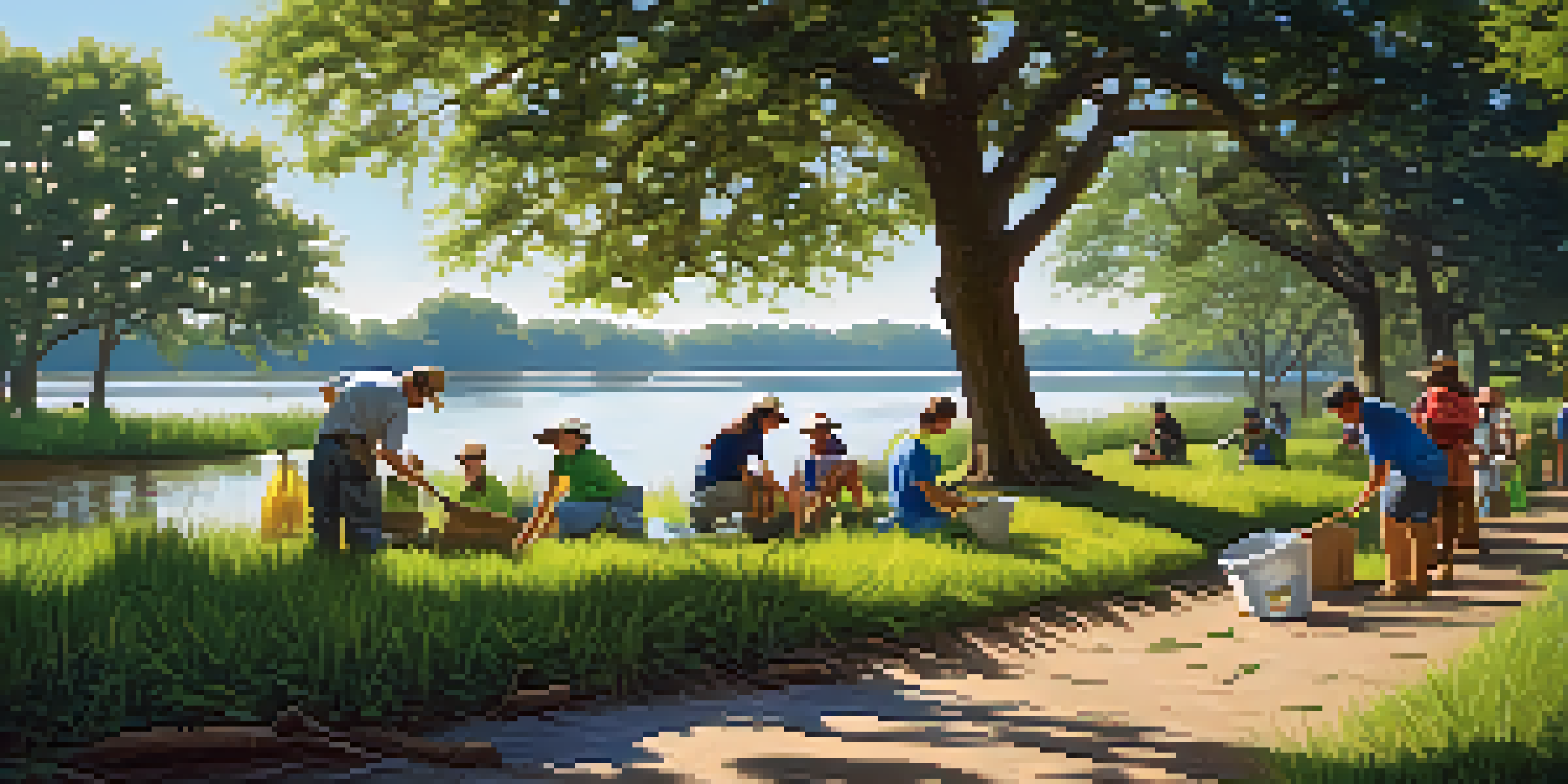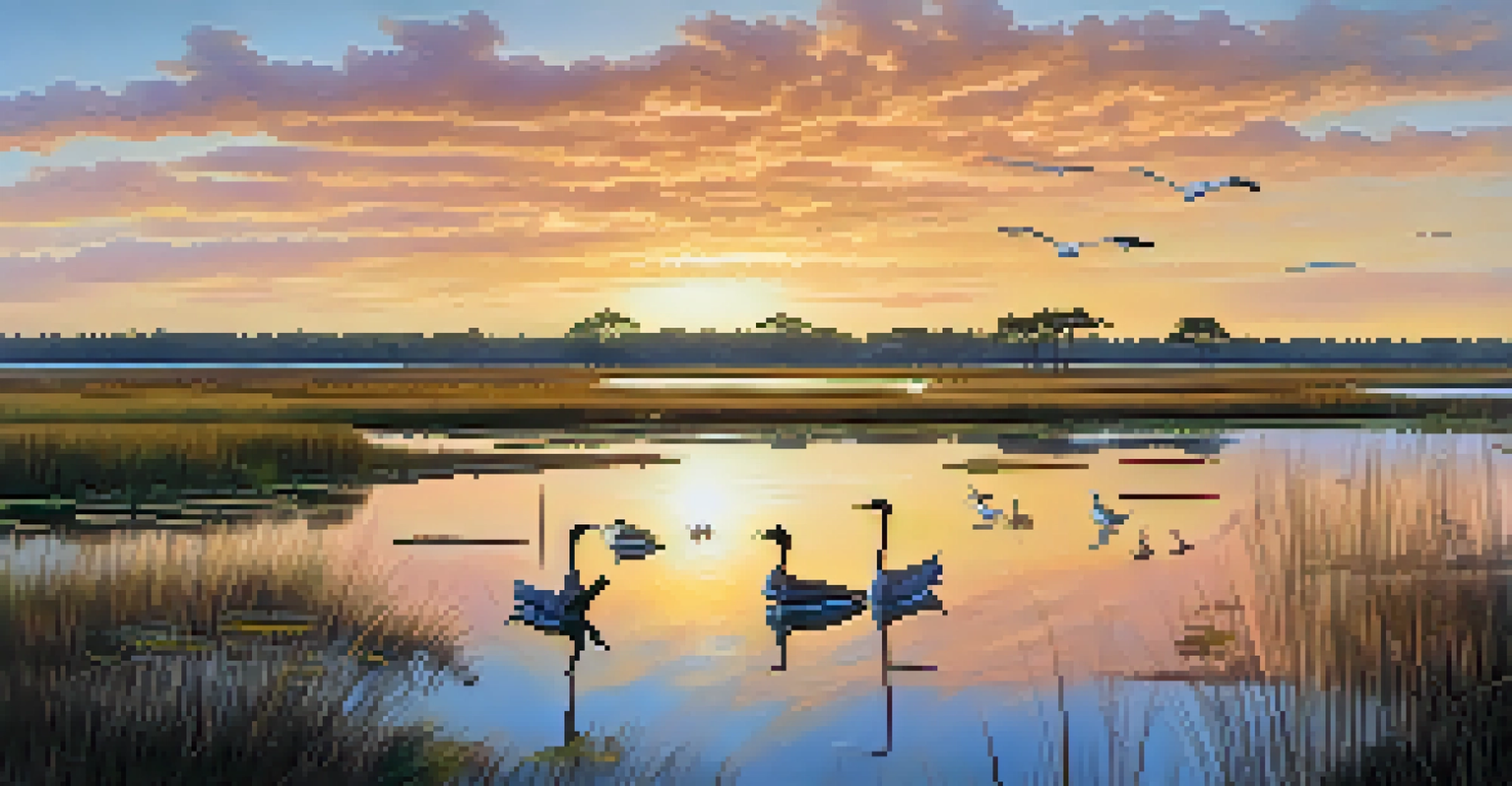Collaborative Conservation: Partnerships in Savannah's Ecosystem

The Importance of Collaborative Conservation in Savannah
Savannah, with its rich biodiversity and unique landscapes, is a prime example of how collaborative conservation can flourish. By pooling resources and expertise, various stakeholders—ranging from government agencies to local communities—can tackle environmental challenges more effectively. This partnership approach not only enhances the conservation efforts but also strengthens community ties and promotes shared responsibility.
In every community, there is work to be done. In every nation, there are wounds to heal. In every heart, there is the power to do it.
Consider the Savannah River, a vital waterway that nourishes both the ecosystem and the communities around it. Collaborative efforts among local governments, environmental organizations, and residents aim to protect this resource from pollution and over-extraction. This unified stance ensures that everyone has a stake in preserving the river's health for future generations.
Ultimately, collaboration leads to innovative solutions that benefit the environment and the people who depend on it. When diverse groups come together, they can share insights, identify best practices, and create a more resilient ecosystem, making Savannah a model for conservation efforts elsewhere.
Key Stakeholders in Savannah's Conservation Efforts
The success of collaborative conservation in Savannah hinges on the involvement of various stakeholders, including governmental bodies, non-profits, local businesses, and citizens. State and local agencies often lead the charge by creating policies and programs that encourage conservation practices. However, it's the grassroots movements that can ignite passion and drive community engagement.

For example, local non-profits often organize cleanup events, educational programs, and habitat restoration projects that invite community participation. These initiatives not only foster a sense of ownership but also educate residents about their local ecosystem. When citizens understand the value of their environment, they become more invested in its protection.
Collaboration Enhances Conservation
Pooling resources and expertise among stakeholders strengthens conservation efforts and community ties in Savannah.
Additionally, businesses can play a crucial role by adopting sustainable practices and supporting local conservation initiatives. By working together, these stakeholders can create a robust network that amplifies the impact of their conservation efforts and sets an example for other regions.
Successful Case Studies of Collaborative Conservation
One shining example of collaborative conservation in Savannah is the partnership between the Georgia Department of Natural Resources and local conservation organizations focused on the coastal marshes. This collaboration has resulted in significant habitat restoration and improved water quality, showcasing how pooling expertise can yield impressive results. The outcome not only benefits the wildlife but also enhances recreational opportunities for the community.
Alone we can do so little; together we can do so much.
Another noteworthy case is the Savannah Riverkeeper, which works tirelessly to protect the river through advocacy, education, and community engagement. By fostering collaboration among local residents, businesses, and governmental agencies, they have successfully mobilized support for cleaner water initiatives. Their efforts demonstrate the power of community action in driving environmental change.
These case studies illustrate that when various groups come together with a shared goal, they can achieve remarkable outcomes. Such collaborations serve as inspiration for future conservation efforts and emphasize the importance of unity in safeguarding our natural resources.
Challenges Faced in Collaborative Conservation
While collaborative conservation offers numerous benefits, it’s not without its challenges. One significant hurdle is the differing priorities and objectives among stakeholders. For example, a local business might prioritize economic growth, while an environmental group focuses on ecosystem protection, leading to potential conflicts.
Communication also plays a crucial role; misunderstandings can easily arise when parties fail to articulate their goals or concerns clearly. Establishing a common language and building trust through open dialogue is essential to overcoming these barriers. Without effective communication, collaborative efforts may falter, and the momentum for conservation could be lost.
Education Fuels Community Engagement
Informing residents about local ecosystems fosters a sense of stewardship and encourages participation in conservation initiatives.
Additionally, securing funding and resources can be daunting, especially in a landscape where competition for grants and support is fierce. Finding sustainable funding sources is crucial for ensuring that collaborative initiatives can continue long-term, allowing stakeholders to maintain their commitment to conservation.
The Role of Education in Collaborative Conservation
Education serves as a cornerstone of successful collaborative conservation efforts in Savannah. By informing the community about local ecosystems and conservation practices, stakeholders can cultivate a deeper appreciation for the environment. Schools, local organizations, and volunteers often work together to create educational programs that engage residents of all ages.
For instance, interactive workshops and field trips to local natural reserves can help participants understand the interconnectedness of Savannah's ecosystem. When individuals are equipped with knowledge, they are more likely to advocate for conservation and participate in collaborative initiatives. This grassroots education fosters a sense of stewardship that is vital for long-term success.
Moreover, leveraging social media and community outreach can amplify educational efforts, reaching a broader audience and inspiring action. By connecting with the community in relatable ways, conservationists can motivate individuals to become active participants in safeguarding Savannah's natural resources.
Leveraging Technology for Collaborative Conservation
Technology has emerged as a powerful ally in collaborative conservation efforts, enabling stakeholders to share information and resources more effectively. Tools like Geographic Information Systems (GIS) allow conservationists to map ecosystems, track changes, and analyze data to make informed decisions. This technology enhances collaboration by providing a common platform for stakeholders to visualize and understand conservation challenges.
Social media platforms also play a role by connecting individuals and organizations passionate about conservation. Sharing success stories, challenges, and events fosters a sense of community and encourages participation. Technology can also simplify the organization of cleanup events or awareness campaigns, making it easier for individuals to get involved.
Technology Supports Collaborative Efforts
Leveraging technology streamlines communication and data sharing, enriching conservation efforts and community involvement.
Ultimately, leveraging technology enhances collaboration by streamlining communication and data sharing. This not only enriches conservation efforts but also builds a more engaged and informed community, paving the way for a healthier Savannah ecosystem.
Future Directions for Collaborative Conservation in Savannah
Looking ahead, the future of collaborative conservation in Savannah appears promising, especially as more stakeholders recognize the importance of working together. Initiatives aimed at enhancing urban green spaces and protecting natural habitats are gaining traction, reflecting a growing commitment to sustainability. These efforts can lead to healthier ecosystems while enhancing the quality of life for residents.
Moreover, fostering partnerships with academic institutions can drive research initiatives that inform conservation strategies. By collaborating with universities, stakeholders can access valuable data and expertise that can help shape effective conservation practices. This synergy between research and community action can lead to innovative solutions for the challenges ahead.

As Savannah continues to grow and change, embracing collaboration will be crucial for maintaining its unique ecosystems. By building on past successes and learning from challenges, the community can create a sustainable future that honors both its natural heritage and its residents.